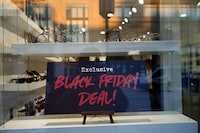
But analysts and industry experts caution that Black Friday sales could be subdued this year. Earlier and steeper sales — while beneficial for strategic shoppers — are hurting retailers whose margins are suffering from a glut of inventory and growing labor costs.
Meanwhile, consumers are showing signs of fatigue after contending with decades-high inflation for much of the year. They got a bit of a reprieve in October: Prices rose 7.7 percent from the year-ago period, according to federal data released earlier this month. Though still far above normal levels, it was lower than analysts had expected. Even wealthier Americans are feeling pinched, polls show. They’re still buying, but choosing less expensive options.
“We are in unique economic situations — inflation has been at a 40-year high and a lot of families’ budgets are being squeezed from all fronts,” said Jie Zhang, a professor of marketing at the University of Maryland. “So there isn’t as much enthusiasm to open up wallets coming into this holiday shopping season.”
Third-quarter financial results, consumer surveys and retail sales data offer a glimpse at how Black Friday may play out. Last week, the Census Bureau reported that retail sales surged 1.3 percent in October. But much of that spending was on necessities like food and gasoline. Americans also continued to pull back on technology and appliances.
These numbers are important to economists and policymakers because consumer spending accounts for more than two-thirds of the U.S. economy. Cooling demand raises recession fears. At the same time, the Federal Reserve has been trying to bring prices down by raising interest rates. The labor market has remained strong, which has helped consumers continue to spend.
In its holiday forecast, the National Retail Federation said sales would grow 6 to 8 percent across all categories and digital purchases will climb 10 to 12 percent. Estimates are not adjusted for inflation. The average shopper will spend $832.84 on gifts and holiday items, the NRF said, which is in line with the 10-year average.
Over the last few years the novelty of Black Friday, which got its name because the rush of sales could change the retailers’ books from red to black, has slowly diminished.
The major shopping day was once synonymous with doorbuster deals and long lines before dawn. Sunil Singh, 61, used to look forward to Black Friday — not just for the steep discounts on tech gadgets but also because it meant spending time with his son. The two had a tradition of lining up before sunrise outside of Best Buy in the San Fransisco Bay Area in anticipation of its opening.
“That whole waking up at 4 a.m., lining up, you know, drinking hot cider and coffee in the line, waiting for two hours, chatting with people, it was just a really fun time,” said Singh, of Mountain View, Calif.
But when his son grew up and online shopping became easier and more prolific, there was little need to show up for in-person sales.
“The deals, you can get them online,” he said. “You’re getting such great deals weeks, ten days ahead. So, it’s no longer that meaningful.”
“It’s lost its novelty,” Singh added.
The rise of e-commerce splintered the Black Friday shopping experience. Now, retailers are making it easier than ever for people to buy on their websites, apps and in-store, said Harley Finkelstein, the president of e-commerce platform Shopify.
“I think Black Friday, Cyber Monday [have] sort of morphed from a weekend into a season,” Finkelstein added. “And I think consumers like that because it means they can get more of their shopping done earlier.”
Shoppers also are increasingly reliant on social media: A global survey by the IBM Institute for Business Value, in association with the National Retail Federation, found that 6 in 10 shoppers draw “inspiration and ideas” from TikTok, Instagram and other sites. The platforms allow for a seamless browse-to-buy shopping experience, and with younger demographics spending more of their time on the apps, brands and companies are bringing their products to them.
But retailers are still making moves to get people back in stores, said Shawn Grain Carter, a professor at the Fashion Institute of Technology.
“If you go into the physical store, oftentimes they have additional doorbuster sales because they’re trying to drive traffic,” she said, adding that after years of covid fears and crowd restrictions, shoppers want to be back in stores. “The pandemic has forced more consumers to realize they want human connection and contact.”

